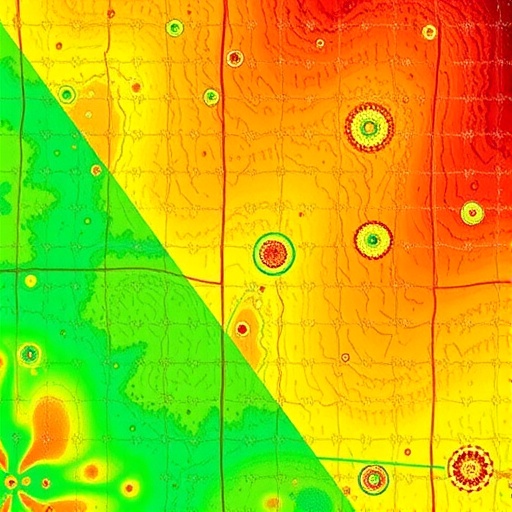In an era where precision and efficiency are paramount in manufacturing, the advent of advanced detection technologies is revolutionizing the inspection of machined surfaces. A recent study by Tang and Chen highlights a novel intelligent detection method that harnesses an image nonlinear processing algorithm tailored for the analysis of machined surface materials. This innovation represents a significant leap forward in ensuring quality and precision in manufacturing processes, impacting various industries from automotive to aerospace.
The core of the study focuses on the challenges faced in traditional defect detection methods. Conventional techniques often struggle with accurately identifying superficial defects that may not be visible to the naked eye, leading to potential flaws in production. By adopting a sophisticated image nonlinear processing algorithm, the researchers aim to enhance the detection capabilities, enabling clearer visualization of material imperfections even under challenging conditions. This has profound implications for manufacturing, where even minor defects can result in significant functional failures.
In their findings, Tang and Chen detail how traditional methods of defect detection tend to rely heavily on manual inspection or basic image processing techniques. These methods can be labor-intensive and prone to human error, ultimately impacting the quality standards that modern manufacturing demands. The research posits that by employing advanced algorithms capable of nonlinear processing, it becomes possible to automate and refine the defect detection phase comprehensively. The implications of this shift are vast, potentially reducing inspection time while increasing accuracy and reliability.
The study puts forward a multi-tiered approach for implementing the intelligent detection technology. At the initial stage, high-resolution images of machined surfaces are captured utilizing state-of-the-art imaging technologies. Following this, the nonlinear processing algorithm is employed to analyze the images, which enhances features that are indicative of defects. This approach not only identifies visible inconsistencies but also extrapolates data concerning the material’s structural integrity.
A standout aspect of the nonlinear processing algorithm is its ability to discern complex patterns within the imaging data that conventional techniques often overlook. This is particularly crucial in detecting subsurface defects or anomalies that could compromise the machined component’s performance. As manufacturing processes become more intricate, leveraging such advanced imaging techniques is increasingly essential. Tang and Chen’s research underscores how these algorithms can facilitate a more holistic understanding of material conditions.
Furthermore, the researchers conducted extensive validation tests to ensure the reliability of their algorithm against existing methods. Through comparative analysis, it was shown that their technique significantly reduces false positives and negatives in defect detection, which is a critical factor in maintaining quality assurance. Such outcomes can save manufacturers substantial time and costs incurred due to defects, bolstering overall production efficiency.
The impact of this research extends beyond immediate manufacturing concerns; it touches upon broader economic implications. As industries adopt more intelligent and automated solutions, the potential for increased productivity is immense. By minimizing errors and enhancing quality control mechanisms through sophisticated image processing technologies, manufacturers can achieve improved yields and reduced wastage, ultimately leading to more sustainable production practices.
Moreover, this study also opens avenues for further exploration into the application of artificial intelligence within manufacturing. The utilization of machine learning algorithms alongside nonlinear image processing could provide even deeper insights into defect prediction and prevention. As such, the research by Tang and Chen serves as a foundational step for future innovations that could transform manufacturing quality control.
Importantly, the study emphasizes the importance of interdisciplinary collaboration to foster advancements in intelligent manufacturing technologies. By combining expertise in materials science, computer science, and engineering, researchers and industry professionals can synergize their knowledge to develop more effective solutions that address complex manufacturing challenges. This collective approach could lead to further breakthroughs, ultimately enhancing the competitive edge of industries engaged in high-precision manufacturing.
Considering the rapid pace of technological advancements, it is imperative for industry stakeholders to stay informed about emerging technologies like the one presented in this study. As manufacturers strive to elevate quality standards, integrating intelligent detection technologies will be critical. This not only marks a shift in quality assurance protocols but also aligns with the broader trend of digital transformation in manufacturing.
In conclusion, the intelligent detection technology developed by Tang and Chen represents a pivotal advancement in the quest for superior quality in manufacturing. By harnessing nonlinear processing algorithms for image analysis, their approach promises to revolutionize how machined surfaces are inspected. As industries increasingly prioritize precision and efficiency, the implications of such innovations will undoubtedly resonate across the manufacturing landscape, paving the way for more intelligent, automated future manufacturing environments.
In the quest for maintaining high standards, the integration of such technology is crucial for maintaining competitiveness in the market. As this research gains traction, it will be interesting to observe how rapid technological advancements will continue to shape the future of manufacturing and quality control.
Subject of Research: Intelligent detection technology for machined surfaces using image nonlinear processing algorithms.
Article Title: Intelligent detection technology of machined surface materials based on image nonlinear processing algorithm.
Article References:
Tang, A., Chen, Y. Intelligent detection technology of machined surface materials based on image nonlinear processing algorithm.
Discov Artif Intell 5, 345 (2025). https://doi.org/10.1007/s44163-025-00591-4
Image Credits: AI Generated
DOI: https://doi.org/10.1007/s44163-025-00591-4
Keywords: intelligent detection technology, machined surfaces, image processing, manufacturing quality control, nonlinear processing algorithm.




